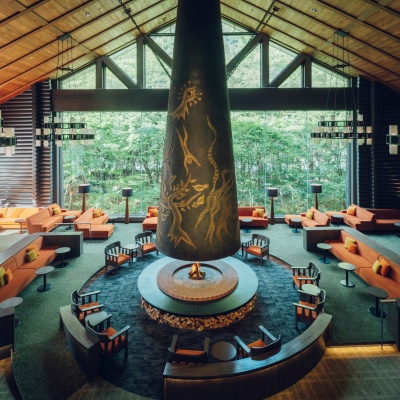3 days/2 nights based in Tsugaru area [Base! Tohoku]
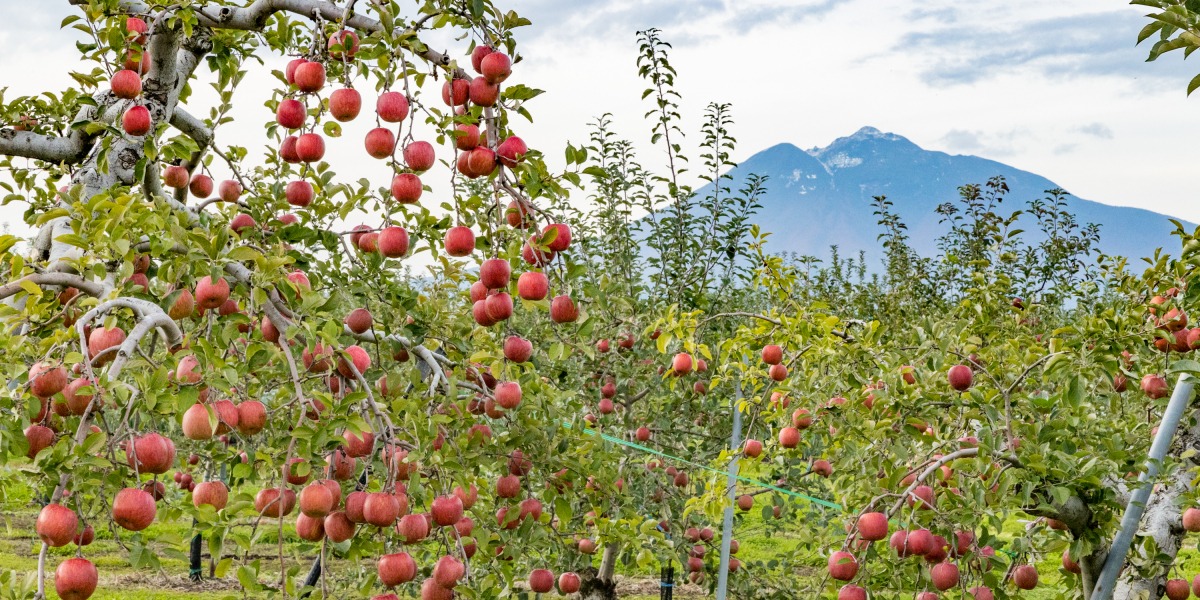
From the World Heritage Site of Shirakami Mountains to the retro architecture of Hirosaki, this is a greedy trip that allows you to enjoy a wide variety of activities.
Enjoy the nature, history and culture of the vast Tsugaru area.
START
Day1
Hirosaki Park (Hirosaki Castle Ruins)
Enjoy Hirosaki Castle and the beauty of the four seasons
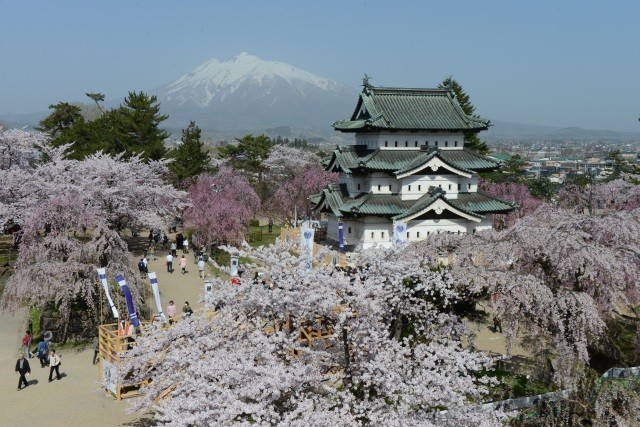
Hirosaki Castle was constructed back in 1611. The castle and the surrounding park opened as Hirosaki Park in May 1895 and has been enjoyed by many locals and visitors ever since.
The castle keep, five castle gates, and three corner turrets that have remained from the Edo period (1603-1867) are designated as National Important Cultural Properties.
Hirosaki Park is home to approximately 2,600 cherry trees of 52 varieties, making it one of the "Three Best Cherry Blossom Viewing Spots in Japan. There are many highlights, such as somei-yoshino, the oldest cherry tree in Hirosaki Park that is 140 years old, the illuminated yozakura (cherry blossoms at night), and "hanaikada," or flower rafts of cherry petals that cover the entire moat. The Hirosaki Cherry Blossom Festival, held every year from late April to early May, attracts many people from within and outside of the prefecture.
Currently, Hirosaki Castle's keep is being moved to the inner side of the castle's main citadel for repairs to the stonewalls, and for this limited time only, visitors can enjoy taking pictures of the keep and the cherry blossoms together with Mt. Iwaki.
In autumn, about 1,000 maple trees and 2,600 cherry trees turn brilliant colors, and chrysanthemum decorations and floral art adorn the site in the Hirosaki Castle Chrysanthemum and Autumn Leaves Festival. In winter, about 150 snow lanterns and snow statues handmade by citizens and about 300 miniature kamakura (Japanese igloos) lit with lights create a fantastic world in the Hirosaki Castle Snow Lantern Festival, offering beautiful seasonal scenes.
The castle keep, five castle gates, and three corner turrets that have remained from the Edo period (1603-1867) are designated as National Important Cultural Properties.
Hirosaki Park is home to approximately 2,600 cherry trees of 52 varieties, making it one of the "Three Best Cherry Blossom Viewing Spots in Japan. There are many highlights, such as somei-yoshino, the oldest cherry tree in Hirosaki Park that is 140 years old, the illuminated yozakura (cherry blossoms at night), and "hanaikada," or flower rafts of cherry petals that cover the entire moat. The Hirosaki Cherry Blossom Festival, held every year from late April to early May, attracts many people from within and outside of the prefecture.
Currently, Hirosaki Castle's keep is being moved to the inner side of the castle's main citadel for repairs to the stonewalls, and for this limited time only, visitors can enjoy taking pictures of the keep and the cherry blossoms together with Mt. Iwaki.
In autumn, about 1,000 maple trees and 2,600 cherry trees turn brilliant colors, and chrysanthemum decorations and floral art adorn the site in the Hirosaki Castle Chrysanthemum and Autumn Leaves Festival. In winter, about 150 snow lanterns and snow statues handmade by citizens and about 300 miniature kamakura (Japanese igloos) lit with lights create a fantastic world in the Hirosaki Castle Snow Lantern Festival, offering beautiful seasonal scenes.
Hirosaki Apple Park
A family-friendly park where you can experience apple picking
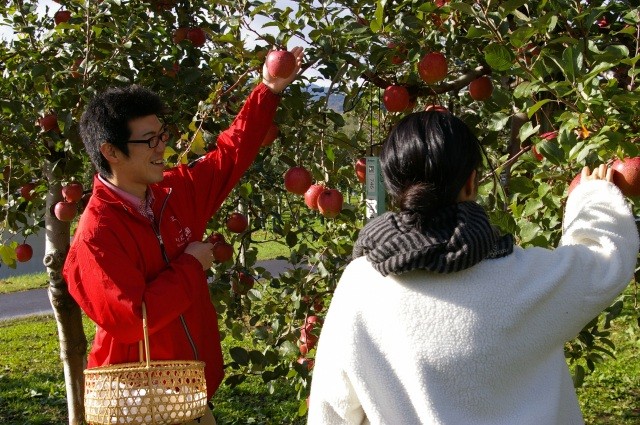
Hirosaki Apple Park covers an area of approximately 9.7 hectares, with 2,300 apple trees and around 80 varieties. This is a spot where visitors can try apple harvesting and also the opportunity to try these delicious varieties from this famous apple region in a variety of forms.
Visitors can pick apples in the park from early August to mid-November. The taste of freshly-picked apples is exceptional! The time of the year when you can experience it varies depending on the growing conditions, so please check in advance. Visitors can freely stroll along the garden paths and enjoy the beautiful view of Mt. Iwaki beyond the apple orchard.
Ringo no Ie (Apple House) sells about 1,200 apple-related products, including original local handicrafts made with apple motifs and apple sweets. At the snack corner, enjoy apple curry, apple sundaes, cider, and other apple delicacies. At the Hirosaki Cider Kobo Kimori, visitors can learn about cider brewing.
There is also a playground and a picnic area, which is popular with families.
There is also the Former Osanai Family Residence in the park, a reconstructed farmhouse where old farm equipment is on display, and the Tsugaru Folktales, where folktales are told in the Tsugaru dialect on weekends and holidays from April to November.
Visitors can pick apples in the park from early August to mid-November. The taste of freshly-picked apples is exceptional! The time of the year when you can experience it varies depending on the growing conditions, so please check in advance. Visitors can freely stroll along the garden paths and enjoy the beautiful view of Mt. Iwaki beyond the apple orchard.
Ringo no Ie (Apple House) sells about 1,200 apple-related products, including original local handicrafts made with apple motifs and apple sweets. At the snack corner, enjoy apple curry, apple sundaes, cider, and other apple delicacies. At the Hirosaki Cider Kobo Kimori, visitors can learn about cider brewing.
There is also a playground and a picnic area, which is popular with families.
There is also the Former Osanai Family Residence in the park, a reconstructed farmhouse where old farm equipment is on display, and the Tsugaru Folktales, where folktales are told in the Tsugaru dialect on weekends and holidays from April to November.
Nakano Momiji-yama (Nakano Maple Mountain)
A famous autumn colours viewing spot with a night-time illumination that’s a must-see
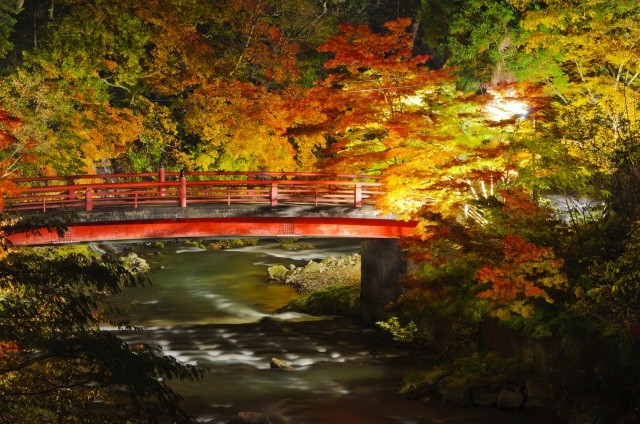
The autumn colours of Nakano Maple Mountain make it a leading spot for viewing foliage even in Aomori Prefecture. It is a historic foliage viewing spot that is said to have begun when the feudal lord of the Hirosaki Domain, Tsugaru Yasuchika, ordered for 100 varieties of maple seedlings to be transplanted from Kyoto. The foliage is so red that it appears to be on fire during the day, and the illuminated foliage is reflected on the waterfall and stream at night, creating a wondrous space.
The area around Nakano Shrine at the foot of the mountain bustles with people as events such as illuminations are held during the autumn colours season. Please enjoy the maple leaves at night, which are just as captivating as cherry trees at night.
The area around Nakano Shrine at the foot of the mountain bustles with people as events such as illuminations are held during the autumn colours season. Please enjoy the maple leaves at night, which are just as captivating as cherry trees at night.
Oirase Keiryu Hot Spring

Day2
Shirakami Sanchi Mountain Range
This must-see UNESCO World Heritage Site is home to enchanting primeval beech forests and the distinctive cobalt-blue Ao-Ike Pond

Shirakami Sanchi, a UNESCO World Heritage Site is a mountainous area extending across Aomori and Akita. It is home to one of the world’s largest primeval beech forests stretching over 130,000 hectares, 17,000 hectares of which are designated Natural Heritage. Although much of the designated area is unexplored, there are various hiking trails available through the pristine natural surroundings of Shirakami Sanchi.
The Juniko (twelve lakes) Hiking Trail is the most popular scenic path. Leaving the souvenir shop Mori-no-Bussankan Kyororo, the 40-minute circular trail takes visitors to Ketoba-no-Ike Pond, the distinctive cobalt-blue Ao-Ike Pond, primeval beech forests, Wakitsubo-no-Ike Pond and Ochikuchi-no-Ike Pond. Ao-Ike Pond, the highlight of the trail, captivates visitors with its mysterious clear blue water. The pond varies in colour depending on the season, the best season is said to be from April to August thanks to the high angle of the sun.
After your walk, take a break at the Mori-no-Bussankan Kyororo souvenir shop where a range of refreshments is available. Our recommendations are the exclusive fresh juice and soup made with the locally produced super-sweet carrots known as Fukaura Yuki Ninjin. Other walking options include a 20-minute return trail from Tsugaru-Toge Pass to the 400-year-old Mother Tree or a 15-minute trail from the car park to Kurokuma Falls, one of Japan’s 100 greatest waterfalls. Enjoy a walk along one of the many hiking trails suitable for all levels!
The Juniko (twelve lakes) Hiking Trail is the most popular scenic path. Leaving the souvenir shop Mori-no-Bussankan Kyororo, the 40-minute circular trail takes visitors to Ketoba-no-Ike Pond, the distinctive cobalt-blue Ao-Ike Pond, primeval beech forests, Wakitsubo-no-Ike Pond and Ochikuchi-no-Ike Pond. Ao-Ike Pond, the highlight of the trail, captivates visitors with its mysterious clear blue water. The pond varies in colour depending on the season, the best season is said to be from April to August thanks to the high angle of the sun.
After your walk, take a break at the Mori-no-Bussankan Kyororo souvenir shop where a range of refreshments is available. Our recommendations are the exclusive fresh juice and soup made with the locally produced super-sweet carrots known as Fukaura Yuki Ninjin. Other walking options include a 20-minute return trail from Tsugaru-Toge Pass to the 400-year-old Mother Tree or a 15-minute trail from the car park to Kurokuma Falls, one of Japan’s 100 greatest waterfalls. Enjoy a walk along one of the many hiking trails suitable for all levels!
Aoike (Blue Pond)
This mysterious blue water fascinates visitors to the World Heritage Site of Shirakami Sanchi

Famous for its brilliant cobalt blue water, Ao-Ike Pond is located in Shirakami Sanchi, a World Heritage Site. The pond is surrounded by one of the world’s largest primeval beech forests stretching over 130,000 hectares, 17,000 hectares of which are designated Natural Heritage. Although much of the designated area is unexplored, there are various hiking trails available through the pristine natural surroundings of Shirakami Sanchi.
The Juniko (twelve lakes) Hiking Trail is the most popular scenic path. Leaving the souvenir shop Mori-no-Bussankan Kyororo, the 40-minute circular trail takes visitors to Ketoba-no-Ike Pond, the distinctive cobalt-blue Ao-Ike Pond, primeval beech forests, Wakitsubo-no-Ike Pond and Ochikuchi-no-Ike Pond. Ao-Ike Pond, the highlight of the trail, captivates visitors with its mysterious clear blue water. The pond varies in colour depending on the season, the best season is said to be from April to August thanks to the high angle of the sun.
The water is so clear that a fallen tree can be seen lying on the bottom of the pond with an inky-blue appearance. The mystery of the pond’s blue water remains unsolved, come and see this miracle of nature for yourself!
A thematic journey in the Tohoku region:Nature・Spectacles
The Juniko (twelve lakes) Hiking Trail is the most popular scenic path. Leaving the souvenir shop Mori-no-Bussankan Kyororo, the 40-minute circular trail takes visitors to Ketoba-no-Ike Pond, the distinctive cobalt-blue Ao-Ike Pond, primeval beech forests, Wakitsubo-no-Ike Pond and Ochikuchi-no-Ike Pond. Ao-Ike Pond, the highlight of the trail, captivates visitors with its mysterious clear blue water. The pond varies in colour depending on the season, the best season is said to be from April to August thanks to the high angle of the sun.
The water is so clear that a fallen tree can be seen lying on the bottom of the pond with an inky-blue appearance. The mystery of the pond’s blue water remains unsolved, come and see this miracle of nature for yourself!
A thematic journey in the Tohoku region:Nature・Spectacles
Koganesaki Furofushi Onsen
Release yourself from the ordinary in this gourd-shaped seaside open-air bath!

Koganesaki Furofushi Onsen is a seaside hot spring featuring an open-air bath looking out onto the sea. Indulge in an exceptionally luxurious soak in this open-air bath while enjoying the dazzling view of the glowing sunset over the sea. Day visits are available until 4pm however an overnight stay is recommended to enjoy this stunning sunset view along with the excellent local seafood served for dinner!
Besides the gourd-shaped open-air bath open for mixed bathing, a separate round open-air bath for women is available. All four baths on site are filled with hot spring water flowing directly from its source.
The name Furofushi Onsen comes from the local saying “anyone who enjoys the health benefits of this hot spring will never grow old”. The dark brown hot spring water appears bottomless due to its high iron content. The distinctive brown water is so rich in iron and salt that it will keep warming your insides for hours afterwards!
A thematic journey in the Tohoku region:Hot springs
Besides the gourd-shaped open-air bath open for mixed bathing, a separate round open-air bath for women is available. All four baths on site are filled with hot spring water flowing directly from its source.
The name Furofushi Onsen comes from the local saying “anyone who enjoys the health benefits of this hot spring will never grow old”. The dark brown hot spring water appears bottomless due to its high iron content. The distinctive brown water is so rich in iron and salt that it will keep warming your insides for hours afterwards!
A thematic journey in the Tohoku region:Hot springs
Day3
Senjojiki Coast
Feel as though you have landed on another planet! Take a walk on a vast rocky beach

Senjojiki Coast features a vast ledge that is said to be where a nobleman spread out 1,000 tatami mats and held a banquet long ago. The sight of the strangely shaped rocks called various names such as Ebisu Rock and Kabuto Rock extending out on the coastline is a highlight. It is a spectacle that will give you a wonderous feeling like that of landing on another planet. These uniquely shaped rocks form a silhouette with the evening sun in the background at sunset. It is famous as one of the best places to see the evening sun. It has even been chosen as one of the top 100 sunsets in Japan.
The coast has also been chosen as one of the 55 best bathing spots in Japan. It is a spot that is very popular for sea bathing and camping in the summer. You find shops selling grilled squid nearby. This is a unique sight like a curtain of many dried squid.
Senjojiki Coast is located just across the road from Senjojiki Station of the rapid Resort Shirakami train on the Gono Line. This is an unmanned station without a station building or even walls. There is even a train that stops here for about 15 minutes so tourists have time to take a stroll, so make sure to check the timetable! The steam whistle that sounds to signal that it is a few minutes before departure invokes the sentiment of your trip.
The coast has also been chosen as one of the 55 best bathing spots in Japan. It is a spot that is very popular for sea bathing and camping in the summer. You find shops selling grilled squid nearby. This is a unique sight like a curtain of many dried squid.
Senjojiki Coast is located just across the road from Senjojiki Station of the rapid Resort Shirakami train on the Gono Line. This is an unmanned station without a station building or even walls. There is even a train that stops here for about 15 minutes so tourists have time to take a stroll, so make sure to check the timetable! The steam whistle that sounds to signal that it is a few minutes before departure invokes the sentiment of your trip.
[Tsuruta, Aomori] Tsuru no Mai Bridge
Take a walk across Japan's longest wooden triple-arched bridge
![[Tsuruta, Aomori] Tsuru no Mai Bridge](/lsc/upfile/spot/0100/1690/1001690_2_m.jpg)
Built on July 8, 1994, the triple-arched Tsuru no Mai Bridge is Japan's longest wooden bridge and spans across Tsugaru Fujimi Lake, where the shadow of Mt. Iwaki is beautifully reflected on the water's surface. The bridge is 300 meters long with a gentle arch and is loved by many as a symbol of Tsuruta, a town known for cranes and international cultural exchanges.
It is said that the bridge with Mt. Iwaki in the background resembles a crane flying in the sky, and that those who cross it will live a long life. The view of the bridge that emerges on the lake surface at dawn and the colors of the lake and bridge at sunset are a few reasons why tourists are drawn to this place. It is also a prime spot for photography enthusiasts.
During winter, the bridge and promenade are cleared of snow so driving and sightseeing are possible. *In severe snow storms such as blizzards, roads may be closed due to poor visibility. At sundown, the bridge railings automatically illuminate and you can enjoy soft arched lighting reminiscent of glowing fireflies until 9 in the evening. Free Wi-Fi is available around the bridge. https://www.medetai-tsuruta.jp/15039.html
[About the facilities around the bridge]Across the Tsuru no Mai Bridge is the Fujimi Lake Park and Tanchozuru Natural Park. The Fujimi Lake Park has a picnic area, amusement facilities, and a bbq area (advance reservation required), making it a popular spot for families. *The barbecuing area is currently closed and no longer taking reservations for 2020 due to COVID-19.At the Tanchozuru Natural Park, you can see red-crowned cranes and admission is free every day from 9:00 to 16:00. In April 2020, a new tourist facility, Kokonimo Aruja opened near the parking lot of the bridge. Within walking distance is the Tsuru no Sato Furusato Kan, a history museum that utilizes a traditional folk house. Admission is free from 9:00 to 16:00 every day except from November to March. *Please contact the Tsuruta Town Hall, Planning and Tourism Department for business hours of each tourist facility in 2020.
[MAP]https://www.medetaitsuruta.jp/spot/sightseeing/fujimilakepark.html
[Additional information] There is a hot spring facility, Welfare Center Tsugaru Fujimiso, near the bridge. Visitors who do not have a reservation can use the hot spring for day trips and have meals at the restaurant. http://www.fujimisou.jp/page02/p02.htm The Tsuru no Mai Bridge Travel Guide will be available from mid-April to November. Danburi MikoPa no Kai will host the tour so please contact them for information on times, fees, arrangements for meeting guides, etc. <Tsuru no Mai Bridge Travel Guide - Danburi MikoPa no Kai> Chairman: (Masaaki Takenami) Phone: 090-7660-7386
[Access] From JR Mutsu-Tsuruda Station, we recommend taking a taxi from the station. When Otona no Kyujitsu Kurabu Pass is available, the four areas from JR Mutsu-Tsuruda Station to Tsuru no Mai Bridge (round trip) and Tsuru no Mai Bridge ⇒ Michi no Eki and Michi no Eki ⇒ JR Mutsu-Tsuruda Station will be approximately half price. Details will be posted on the town's tourism website Medetai Tsuruta. https://www.medetai-tsuruta.jp/
A thematic journey in the Tohoku region:Riverside
It is said that the bridge with Mt. Iwaki in the background resembles a crane flying in the sky, and that those who cross it will live a long life. The view of the bridge that emerges on the lake surface at dawn and the colors of the lake and bridge at sunset are a few reasons why tourists are drawn to this place. It is also a prime spot for photography enthusiasts.
During winter, the bridge and promenade are cleared of snow so driving and sightseeing are possible. *In severe snow storms such as blizzards, roads may be closed due to poor visibility. At sundown, the bridge railings automatically illuminate and you can enjoy soft arched lighting reminiscent of glowing fireflies until 9 in the evening. Free Wi-Fi is available around the bridge. https://www.medetai-tsuruta.jp/15039.html
[About the facilities around the bridge]Across the Tsuru no Mai Bridge is the Fujimi Lake Park and Tanchozuru Natural Park. The Fujimi Lake Park has a picnic area, amusement facilities, and a bbq area (advance reservation required), making it a popular spot for families. *The barbecuing area is currently closed and no longer taking reservations for 2020 due to COVID-19.At the Tanchozuru Natural Park, you can see red-crowned cranes and admission is free every day from 9:00 to 16:00. In April 2020, a new tourist facility, Kokonimo Aruja opened near the parking lot of the bridge. Within walking distance is the Tsuru no Sato Furusato Kan, a history museum that utilizes a traditional folk house. Admission is free from 9:00 to 16:00 every day except from November to March. *Please contact the Tsuruta Town Hall, Planning and Tourism Department for business hours of each tourist facility in 2020.
[MAP]https://www.medetaitsuruta.jp/spot/sightseeing/fujimilakepark.html
[Additional information] There is a hot spring facility, Welfare Center Tsugaru Fujimiso, near the bridge. Visitors who do not have a reservation can use the hot spring for day trips and have meals at the restaurant. http://www.fujimisou.jp/page02/p02.htm The Tsuru no Mai Bridge Travel Guide will be available from mid-April to November. Danburi MikoPa no Kai will host the tour so please contact them for information on times, fees, arrangements for meeting guides, etc. <Tsuru no Mai Bridge Travel Guide - Danburi MikoPa no Kai> Chairman: (Masaaki Takenami) Phone: 090-7660-7386
[Access] From JR Mutsu-Tsuruda Station, we recommend taking a taxi from the station. When Otona no Kyujitsu Kurabu Pass is available, the four areas from JR Mutsu-Tsuruda Station to Tsuru no Mai Bridge (round trip) and Tsuru no Mai Bridge ⇒ Michi no Eki and Michi no Eki ⇒ JR Mutsu-Tsuruda Station will be approximately half price. Details will be posted on the town's tourism website Medetai Tsuruta. https://www.medetai-tsuruta.jp/
A thematic journey in the Tohoku region:Riverside
Tachineputa no Yakata (Tachineputa Museum)
Meet Tachineputa standing 23 meters tall!
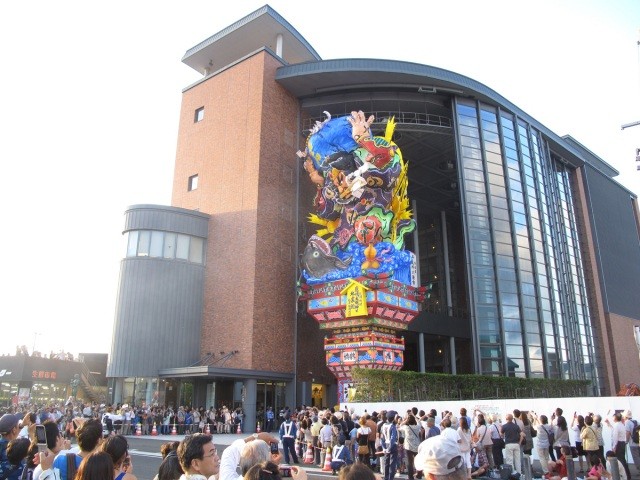
The Goshogawara Tachineputa Festival is one of the three major Aomori Neputa festivals, alongside with the Aomori Nebuta Festival and Hirosaki Neputa Festival. Its appeal lies in the magnificent parade of floats, with the tallest towering more than 20 meters high.
The Tachineputa no Yakata (Tachineputa Museum) is a facility where visitors can admire the power and impact of the Tachineputa. One will undoubtedly be overwhelmed by the Tachineputa that reaches heights equivalent to a four-story building. The exhibition space is a spacious atrium with an open structure extending from the first to the fourth floor, while the area around the Tachineputa is sloped to allow visitors to observe the display from different angles.
Visitors can also watch films of the festival, as well as watch demonstrations and experience playing taiko drums and traditional music accompaniment. It is an impressive facility that is definitely worth a visit.
A thematic journey in the Tohoku region:Festivals
The Tachineputa no Yakata (Tachineputa Museum) is a facility where visitors can admire the power and impact of the Tachineputa. One will undoubtedly be overwhelmed by the Tachineputa that reaches heights equivalent to a four-story building. The exhibition space is a spacious atrium with an open structure extending from the first to the fourth floor, while the area around the Tachineputa is sloped to allow visitors to observe the display from different angles.
Visitors can also watch films of the festival, as well as watch demonstrations and experience playing taiko drums and traditional music accompaniment. It is an impressive facility that is definitely worth a visit.
A thematic journey in the Tohoku region:Festivals
GOAL
